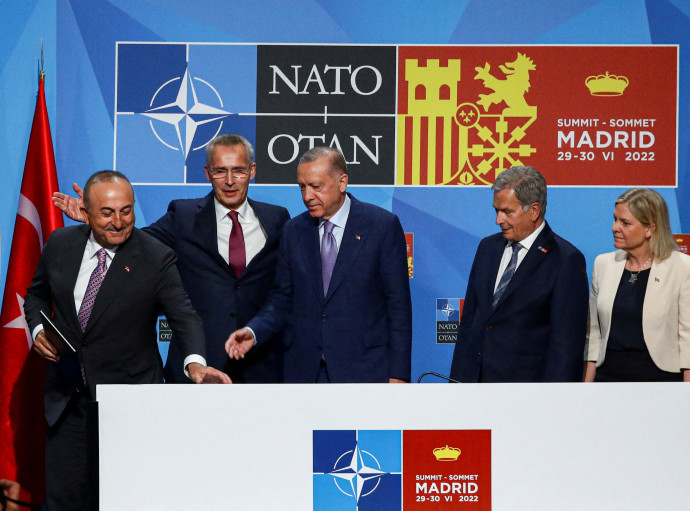Former French diplomat Gérard Araud, in an article published in the French magazine Le Point, argues that Russian President Vladimir Putin is seen as “NATO’s savior.” Three years ago, the alliance was unable to deal with the real threats facing Europe, especially terrorism and illegal immigration.
But after Russia’s war in Ukraine, the situation changed and the alliance became stronger and more united. From a realistic standpoint, this view is quite justified. Most importantly, it raises the fundamental question of the extent to which Russian strategists examined the war plans in Ukraine in all strategic aspects in the short and long term.
This is not only about what can be called the kiss of life for NATO, but also about Russia falling into an attrition trap that undoubtedly affects Western economies, but also has a strong impact on the Russian economy. It also affects Russia’s future as a major competitive force on the international stage.
It is no secret that NATO has been facing a clear identity crisis since the collapse of the former Soviet Union, having failed to achieve its main objective set in 1949 to contain a possible Soviet expansionist threat on the European continent.
With the disintegration of the Warsaw Pact counter-alliance established in 1955, the fall of the Berlin Wall and the collapse of the Soviet Union in 1991, the traits of a new security system began to emerge in Europe. Most of the former Warsaw Pact countries even became members of NATO. In the last decade, NATO actually entered an existential crisis.

This became clear when former US president Donald Trump called it ineffectual. “I think in 100 years people are gonna look back and they’re gonna say, how did we stand back and NATO stand back, which in many ways I’ve called the paper tiger,” Trump said.
France and NATO
French President Emmanuel Macron even called the alliance “brain dead” in 2019 and said it was time for France to leave. Macron has not retracted that statement to date, but recently went on to state that the alliance is in fact dead, but that Russia’s war in Ukraine has given the alliance an “electroshock” of awakening.
This gave NATO the strategic clarity it lacked by emphasizing its importance in countering Russia.
Interestingly, just a few months ago, France was questioning the future of the Atlantic. Last September, French Foreign Minister Jean-Yves Le Drian said Australia’s cancellation of the agreement to buy French submarines and replace them with American nuclear-powered submarines would affect NATO’s future.
Most of NATO’s dilemmas over the past two decades have, of course, involved disputes over the budget-sharing of the alliance, as well as the emergence of serious disagreements between some NATO members, such as the dispute between Turkey and Greece and France, and the bid by Turkey, a key NATO member, to buy Russian weapons systems.
China and NATO
We can also note NATO’s inability to develop an effective strategy toward Russia, the rise of China and the priorities of the alliance in the 21st century. NATO’s strategic vision, “NATO 2030: United for a New Era,” draws attention to Russia’s increasing “aggressiveness,” which will continue to be the alliance’s greatest military challenge in the next decade.
But it paid close attention to China as a growing threat. I believe that NATO’s strength and cohesion are increasing; the question of an unknown future is no longer on the agenda as it has been for the last decade.
The policy of alliance enlargement gained momentum after Finland and Sweden asked to join the alliance, a qualitative shift with important undertones. NATO now includes not only former Warsaw Pact countries, but also countries that remained neutral during the Cold War.
There’s more. The Europeans are planning to increase defense budgets as the number of US troops in Europe has grown from 60,000 to about 100,000. This reflects a renewed US interest in European security, as Washington was about to reduce its commitment to the security of its Atlantic partners.
At the Madrid summit, Biden announced his country’s intention to increase its military presence on the European continent. This includes the establishment of a permanent military command center in Poland, as well as the deployment of warships to Spain, fighter jets to the UK and ground troops to Romania. NATO has announced plans to increase the number of rapid reaction forces from 40,000 to more than 300,000.
This is a major paradigm shift that NATO Secretary-General Jens Stoltenberg called “the biggest overhaul of our collective defense and deterrence since the Cold War.” The alliance has increased the number, size, and quality of its multinational battle groups in Eastern Europe, and has pivoted from its official position on Russia in 2016, when it was considered a “strategic partner,” to viewing Russia as a “direct threat” to NATO security.
It can now be assumed that Russia has completely misjudged the Atlantic response to Ukraine. Differences among NATO members appear to have contributed to Russian planners’ anticipation of a divided NATO and that its members would have difficulty agreeing on a unified position on the war in Ukraine. On balance, this is a gross misjudgment and misinterpretation of the facts.
All in all, NATO today is not the same as it was before the war in Ukraine.
The writer is a UAE political analyst and former Federal National Council candidate.
